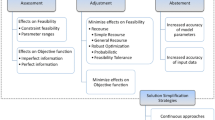Abstract
An industrial decision process supported by quantitative modelling (safety and reliability, physical design of facilities or processes, economic optimisation, environmental impact, etc.) quickly faces a wide diversity of uncertainties, imprecision, errors or alea affecting all data or numerical models. Beyond a terminological heterogeneity that is explicable by historical separation of the fields involved (such as metrology, reliability,separation of the fields involved (such as metrology, reliability, statistics, numerical analysis, ...), this papers introduces a generic and applied approach to uncertainty, derived from years of experience and recently shared by different applied research groups. This methodology is composed of four main steps that enable to distinguish some classical steps in modelling: specification of a criterion of interest to be assessed by a numerical representation of the problem containing uncertain variables (step A), identification and quantification of the sources of uncertainty (step B), propagation of uncertainty through the numerical representation (step C) and ranking of the uncertainties by sensitivity analysis (step D). This approach aims at giving a consistent and industrially realistic framework for practical mathematical modelling, assumingly restricted to quantitative and quantifiable uncertainty. Within this framework, various mathematical settings are possible; however, themixed deterministic–probabilistic setting appears to be central in present-day industrial applications and is the core of this paper. This paper introduces the current status of applied research in this field and points out different initiatives (software, research community) that are dealing with this topic.


Similar content being viewed by others
References
The European Safety, Reliability and Data Association. www.esreda.org
Managing Uncertainty in Complex Models. www.mucm.ac.uk
The Statistical and Applied Mathematical Sciences Institute. www.samsi.info
Institut de Maîtrise des Risques. www.imdr.fr
French Research Group on Stochastic Analysis Methods for COdes and NUMerical treatments, www.gdr-mascotnum.fr
Open Source iniative to Treat Uncertainties, Risks’N Statitics in a structured industrial approach, www.openturns.org
de Rocquigny E, Tarantola S, De Victor N (EsREDA Group, eds) (2008) Uncertainty in industrial practice: a guide to quantitative uncertainty management. Wiley, New York
Andrianov G, Burriel S, Cambier S, Dutfoy A, Dutka-Malen I, de Rocquigny E, Sudret B, Benjamin P, Lebrun, R, Mangeant F, Pendola M (2007) Open TURNS, an open source initiative to Treat Uncertainties, Risks’N Statistics in a structured industrial approach. In: Proc. ESREL’2007 safety and reliability conference. Stavenger, Norway
Ghanem R, Spanos P (1991) Stochastic finite elements: a spectral approach. Springer, Berlin
Saltelli A, Chan K, Scott EM (2000) Sensitivity analysis. Wiley, New York
Acknowledgements
This activity is supported by different organizations (French research agency ANR with the OPUS project) and systematic pole (EHPOC and CSDL project).
Author information
Authors and Affiliations
Consortia
Corresponding author
Rights and permissions
About this article
Cite this article
Mangeant, F., EADS Innovation Works. Joined initiatives around uncertainty management. Ann. Telecommun. 66, 397–407 (2011). https://doi.org/10.1007/s12243-011-0266-7
Received:
Accepted:
Published:
Issue Date:
DOI: https://doi.org/10.1007/s12243-011-0266-7



